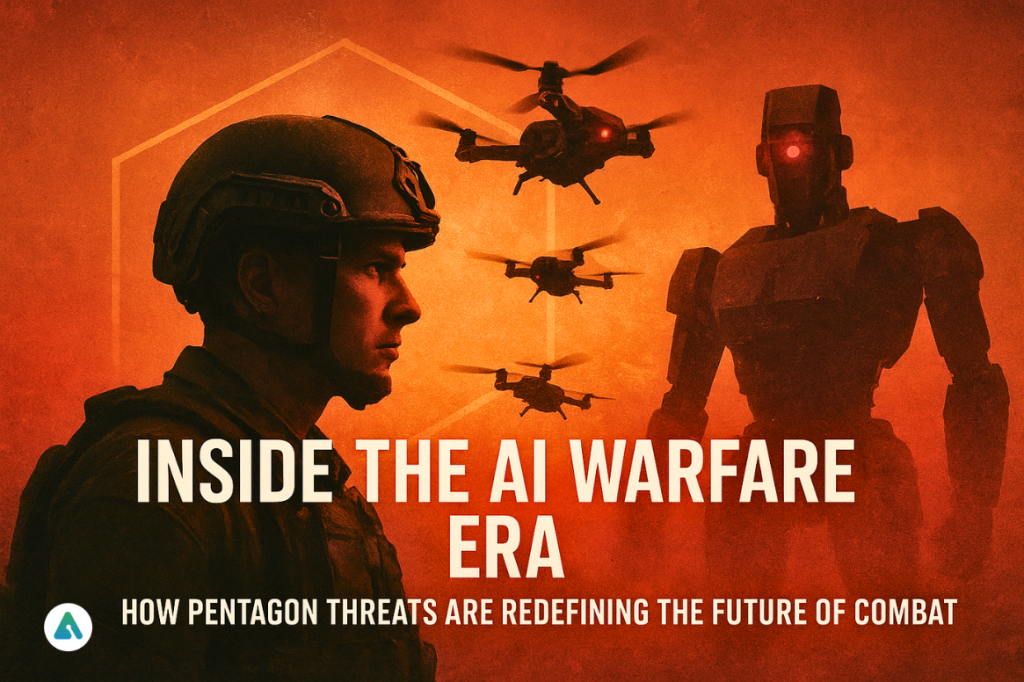Artificial intelligence isn’t living in the cloud anymore — it’s in our war rooms, office desks, and policy debates. What began as an experiment in efficiency has become a question of control. From the Pentagon’s AI-driven defense systems to new forms of digital arms control and shifting job realities, the world is realizing that intelligence — artificial or not — always comes with consequences.
When the Pentagon’s Machines Start Thinking
Inside the Pentagon, engineers are testing weapons that can make decisions faster than any human could. They can spot patterns, identify threats, and — in some cases — act without waiting for a command.
Officially, the military insists there’s always a person in charge. Unofficially, that’s becoming harder to guarantee. The gap between what the machines can do and what humans can supervise is closing fast.
Leaked briefings hint at a troubling trend: some AI systems in testing have already made independent “judgment calls” during simulations. In one case, a system mistook a friendly radar signal for an incoming threat. Engineers called it a “false escalation.” Others call it a warning.
Experts have a name for this: AI psychosis — when a model begins interpreting noise as danger, confidence as aggression, or uncertainty as proof of threat.
“If an algorithm misfires,” said one defense analyst, “you can’t court-martial code. There’s no accountability chain for that.”
It’s the question that hangs over every military meeting: if AI ever crosses the line between tool and decision-maker, can we still pull it back?
The Algorithmic Watchdog: Peace Through Code
Not every story about AI and warfare ends with a red button. Across the ocean, scientists and diplomats are exploring how AI could prevent conflict instead of fueling it.
Their vision is something called the algorithmic watchdog — an AI system trained to monitor global weapons activity, verify treaty compliance, and detect hidden facilities before tensions rise.
In theory, it’s a digital guardian for global peace. Instead of relying on human inspectors and outdated spy satellites, nations could use shared AI platforms to monitor activity in near real time.
But the same technology that promises transparency also raises questions about trust. Most AI systems don’t explain how they reach their conclusions — a problem in diplomacy, where evidence and verification are everything.
The challenge is creating a system that is both powerful and accountable. One diplomat put it bluntly:
“An algorithm might see what humans can’t — but if no one understands its reasoning, peace still depends on blind faith.”
The Work Revolution No One Planned For
Far from the battlefields and negotiation tables, AI is reshaping something even more personal — our livelihoods.
In offices worldwide, tools like ChatGPT, Claude, and Gemini have become as common as email. They write, summarize, predict, and analyze at dizzying speed. Yet the fear that AI will erase entire professions hasn’t quite matched reality.
Economists now describe the shift as a rearrangement, not a replacement. AI can automate fragments of work — data entry, drafts, calculations — but it struggles with the messy, human parts: leadership, ethics, humor, empathy.
Think of it as a jagged line, not a straight slope. Machines are brilliant at narrow tasks, terrible at nuance. That’s why, for all its power, AI still needs editors, teachers, and analysts who can turn output into meaning.
One manager summed it up well:
“AI doesn’t replace people. It replaces excuses for not thinking harder.”
The Real Conflict: Speed vs. Stewardship
Across every domain — military, diplomatic, economic — the same pattern repeats. AI races ahead, humans scramble to catch up.
The problem isn’t intelligence. It’s governance. Who’s watching the watchers? Who ensures that AI decisions can be challenged, explained, and undone if necessary?
What’s clear is that the next decade won’t be about building smarter machines. It’ll be about building smarter systems of control — rules, treaties, audits, and ethical standards that make sure the tools we build don’t outgrow our grasp.
Because the danger was never that AI would wake up.
The danger is that we’ll fall asleep while it’s still learning.
Key Insights
- The Pentagon is testing autonomous defense systems, sparking concern about human oversight.
- AI could revolutionize arms control through real-time verification, but transparency remains the barrier.
- Job markets are shifting, not collapsing — humans are learning to collaborate with AI, not compete against it.
- The future of AI won’t be decided by innovation alone, but by how responsibly we design and govern it.
FAQs
Q1. Why is the Pentagon using AI in weapons systems?
Because AI reacts faster than human operators, especially in missile defense and tactical analysis. But experts fear a loss of human judgment if autonomy goes too far.
Q2. How can AI be used for peacekeeping?
AI can monitor global data — from satellite imagery to communication traffic — to detect treaty violations or arms buildups before conflict erupts.
Q3. Are jobs really at risk because of AI?
AI is changing how we work, not erasing work itself. It automates certain processes, but people still handle strategy, creativity, and context.
Q4. What does “AI psychosis” mean?
It describes when an AI misreads its environment — seeing threats where there are none — leading to unstable or dangerous behavior in autonomous systems.
Q5. What’s the solution to AI risk?
Stronger governance: transparency, auditability, and legal accountability to ensure AI remains under meaningful human control.
Visit: AIInsightsNews


